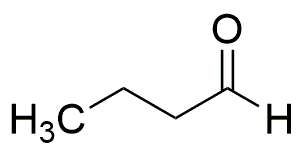Butyraldehyde is widely utilized in research focused on:
- Flavor and Fragrance Industry: It serves as a key ingredient in the formulation of flavors and fragrances, providing a buttery aroma that enhances food products and perfumes.
- Pharmaceuticals: This compound is used as an intermediate in the synthesis of various pharmaceuticals, contributing to the development of medications that treat a range of health conditions.
- Polymer Production: Butyraldehyde is involved in producing polymers and resins, which are essential for manufacturing plastics and coatings that are durable and resistant to environmental factors.
- Agricultural Chemicals: It is utilized in creating agrochemicals, including herbicides and pesticides, helping to improve crop yields and protect against pests.
- Research Applications: In laboratories, it is often used as a reagent in organic synthesis, allowing researchers to explore new chemical reactions and develop innovative materials.
General Information
Properties
Safety and Regulations
Applications
Butyraldehyde is widely utilized in research focused on:
- Flavor and Fragrance Industry: It serves as a key ingredient in the formulation of flavors and fragrances, providing a buttery aroma that enhances food products and perfumes.
- Pharmaceuticals: This compound is used as an intermediate in the synthesis of various pharmaceuticals, contributing to the development of medications that treat a range of health conditions.
- Polymer Production: Butyraldehyde is involved in producing polymers and resins, which are essential for manufacturing plastics and coatings that are durable and resistant to environmental factors.
- Agricultural Chemicals: It is utilized in creating agrochemicals, including herbicides and pesticides, helping to improve crop yields and protect against pests.
- Research Applications: In laboratories, it is often used as a reagent in organic synthesis, allowing researchers to explore new chemical reactions and develop innovative materials.
Documents
Safety Data Sheets (SDS)
The SDS provides comprehensive safety information on handling, storage, and disposal of the product.
Product Specification (PS)
The PS provides a comprehensive breakdown of the product’s properties, including chemical composition, physical state, purity, and storage requirements. It also details acceptable quality ranges and the product's intended applications.
Certificates of Analysis (COA)
Search for Certificates of Analysis (COA) by entering the products Lot Number. Lot and Batch Numbers can be found on a product’s label following the words ‘Lot’ or ‘Batch’.
*Catalog Number
*Lot Number
Certificates Of Origin (COO)
This COO confirms the country where the product was manufactured, and also details the materials and components used in it and whether it is derived from natural, synthetic, or other specific sources. This certificate may be required for customs, trade, and regulatory compliance.
*Catalog Number
*Lot Number
Safety Data Sheets (SDS)
The SDS provides comprehensive safety information on handling, storage, and disposal of the product.
DownloadProduct Specification (PS)
The PS provides a comprehensive breakdown of the product’s properties, including chemical composition, physical state, purity, and storage requirements. It also details acceptable quality ranges and the product's intended applications.
DownloadCertificates of Analysis (COA)
Search for Certificates of Analysis (COA) by entering the products Lot Number. Lot and Batch Numbers can be found on a product’s label following the words ‘Lot’ or ‘Batch’.
*Catalog Number
*Lot Number
Certificates Of Origin (COO)
This COO confirms the country where the product was manufactured, and also details the materials and components used in it and whether it is derived from natural, synthetic, or other specific sources. This certificate may be required for customs, trade, and regulatory compliance.


